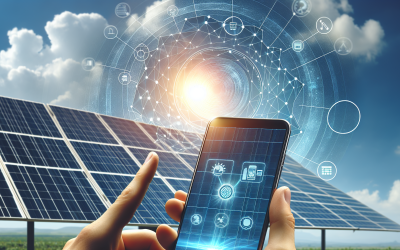In today’s world, where energy efficiency is a key concern, many people are turning to solar panels as a sustainable solution for powering their homes. But can you track your energy consumption in real-time with solar panels? The answer is yes, and there are multiple options available to help you monitor your energy usage. From smart meters and energy management systems to mobile apps and online portals, you can now easily keep tabs on how much electricity your solar panels are producing and how much energy you are consuming. With real-time energy consumption tracking, you can make informed decisions about your energy usage, optimize your solar panel system, and ultimately save money on your utility bills.
Options for Real-time Energy Consumption Tracking with Solar Panels
Introduction to Real-time Energy Consumption Tracking
When it comes to monitoring energy consumption with solar panels, real-time tracking can be a powerful tool. It allows you to keep a constant eye on your energy usage, enabling you to make more informed decisions about your energy consumption habits. In this article, we will explore the different options available for real-time energy consumption tracking with solar panels, as well as the benefits, challenges, and future innovations in this field.
Benefits of Real-time Energy Consumption Tracking
Real-time energy consumption tracking offers several significant advantages. Firstly, it allows you to actively monitor your energy usage, enabling you to identify areas where energy is being wasted and make adjustments accordingly. This can lead to substantial cost savings over time and help you become more energy-efficient.
Additionally, real-time tracking provides valuable insights into how your solar panels are performing. By comparing your energy generation with your consumption patterns, you can optimize the efficiency of your solar panel system and ensure that you are getting the most out of your investment.
Challenges in Real-time Energy Consumption Tracking
While real-time energy consumption tracking offers numerous benefits, it also comes with certain challenges. One of the primary challenges is the availability of accurate and reliable data. In order to track energy consumption in real-time, you need access to precise information about your energy usage. This can be particularly challenging in older homes or buildings that lack modern energy monitoring infrastructure.
Another challenge is the complexity associated with integrating different systems and technologies. Real-time energy consumption tracking often requires the integration of various devices, such as smart meters, inverters, and monitoring apps. This can be a complicated process, requiring technical expertise and potentially additional investments.
1. Home Energy Monitoring Systems
Home energy monitoring systems are an effective way to track your energy consumption in real-time. These systems typically consist of hardware devices that measure and record your energy usage, as well as software applications that provide detailed information and analysis.
1.1 Smart Metering
Smart meters are advanced energy monitoring devices that provide real-time data on your electricity usage. They are typically installed by utility companies and can track your solar energy production, as well as your overall consumption. Smart metering allows you to access detailed information about your energy usage through online platforms or mobile apps.
1.2 Inverter Monitoring
In addition to smart metering, monitoring the performance of your solar panel inverter can provide valuable insights into your energy consumption. Inverters convert the direct current (DC) generated by your solar panels into the alternating current (AC) used by your home appliances. By monitoring your inverter’s efficiency and output, you can assess the overall performance of your solar panel system and identify any potential issues or improvements.
2. Energy Monitoring Apps
Energy monitoring apps are another option for real-time energy consumption tracking. These apps can be installed on your smartphone or tablet, allowing you to monitor your energy usage on the go. They typically connect to your smart meter or inverter, providing you with real-time data and offering features such as usage alerts, historical data analysis, and energy-saving tips.
3. Solar Monitoring Systems
Solar monitoring systems specifically focus on tracking the performance of your solar panels. These systems often come with built-in monitoring capabilities that allow you to monitor energy generation, consumption, and overall system efficiency. Some solar monitoring systems can even provide detailed insights into the individual performance of each solar panel, enabling you to identify and address any issues promptly.
4. Internet of Things (IoT) Solutions
The Internet of Things (IoT) has revolutionized many industries, including energy monitoring. IoT solutions leverage interconnected devices and sensors to provide real-time data and analysis. In the realm of energy consumption tracking, IoT offers several compelling options.
4.1 Energy Monitoring Devices with IoT Capability
There are energy monitoring devices available on the market that have built-in IoT capability. These devices can be easily installed in your electrical panel or connected to your solar panel system, providing you with detailed real-time energy consumption data. With IoT connectivity, these devices can also communicate with other smart devices in your home, allowing for seamless integration and intelligent energy management.
4.2 Cloud-based Monitoring and Analysis
Cloud-based monitoring and analysis platforms are another IoT solution for real-time energy consumption tracking. These platforms collect data from various sources, such as smart meters, inverters, and sensors, and store it in the cloud. This data can then be accessed and analyzed using web-based or mobile applications. Cloud-based solutions offer the advantage of scalability, as they can handle large amounts of data and provide real-time insights from anywhere with an internet connection.
5. Third-Party Energy Management Platforms
Third-party energy management platforms provide comprehensive solutions for real-time energy consumption tracking. These platforms often integrate multiple aspects of energy monitoring, such as smart meter data, solar panel performance, and home energy automation. They offer sophisticated analytics and reporting tools, allowing you to visualize and analyze your energy usage patterns. Additionally, some third-party platforms provide energy-saving recommendations based on machine learning algorithms, helping you optimize your energy consumption.
6. Advanced Analytics and Machine Learning
Advanced analytics and machine learning algorithms can enhance the accuracy and efficiency of real-time energy consumption tracking. By analyzing historical data and identifying usage patterns, these technologies can provide more accurate predictions and recommendations. Machine learning algorithms can also adapt to your energy consumption habits over time, enabling personalized energy management strategies that maximize efficiency and savings.
7. Integration with Smart Home Automation
Integrating real-time energy consumption tracking with smart home automation systems can optimize your energy usage even further. By connecting your energy monitoring devices to other smart devices in your home, such as smart thermostats, lighting controls, or energy-efficient appliances, you can automate energy-saving actions based on real-time data. This integration enables a seamless and intelligent home energy management experience.
8. Retrofitting Existing Solar Panel Systems
If you already have solar panels installed and want to track your energy consumption in real-time, retrofitting your system with energy monitoring devices is a viable option. Retrofitting typically involves the installation of additional hardware components that integrate with your existing solar panel setup. This allows you to leverage the benefits of real-time energy consumption tracking without the need for a complete system overhaul.
9. Future Innovations in Real-time Energy Consumption Tracking
The field of real-time energy consumption tracking continues to evolve, and numerous future innovations are on the horizon. These innovations include advancements in sensor technology, improved data analytics capabilities, and integration with emerging technologies like blockchain. As technology continues to progress, we can expect more accurate, efficient, and user-friendly options for tracking our energy consumption in real-time.
Conclusion
Real-time energy consumption tracking with solar panels offers numerous benefits, such as cost savings, improved energy efficiency, and optimized performance. While there are various options available, including home energy monitoring systems, energy monitoring apps, solar monitoring systems, IoT solutions, third-party platforms, advanced analytics, and integration with smart home automation, it’s essential to choose the option that best fits your needs and budget. As the industry continues to innovate, the future looks promising for real-time energy consumption tracking, paving the way for a greener and more sustainable future.










